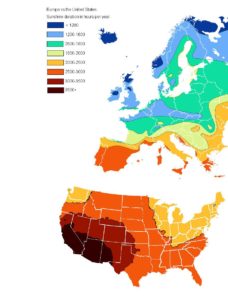Sunshine or sunlight is essential to life on Earth. Sure a small subset of organisms thrive in places that sunshine never reaches, but most are at least indirectly dependent on solar energy. Whether they live in ever-dark caves or in the depths of the oceans most food chains can be linked back to photosynthesizing plants. There are a few exceptions. Deep sea thermal vents that release energy from the Earth’s interior support life with no direct link to sunshine or solar energy.
Admittedly those thermal based life forms are extremely important links to life’s past on Earth, but the biggest step was the evolution of photosynthesizing life. In a nutshell, photosynthesis is the chemical process of using sunshine and carbon dioxide to create sugars. In addition to the synthesized sugars, the process also creates a very important waste product – oxygen. While oxygen is one of the most plentiful elements in the universe, it’s also a very reactive one. It readily forms compounds with almost all of the other elements. Oxygen is like the person who can’t stand to be alone – it’s always hooking up with whoever is available. As such despite it’s commonness free oxygen would not exist on Earth without photosynthesis. If you’re interested in more information about oxygen, here’s a Scientific American article.
Besides being dependent on solar energy to drive our food chain human beings also need sunshine for their well-being. While our skin isn’t photosynthetic, it does utilize sunshine to produce a critical nutrient, vitamin D. Deficiency in vitamin D is linked to increased risk of cancer, heart disease, osteoporosis, multiple sclerosis and many other problems. The skin uses the ultraviolet (UV) B light in sunshine to convert cholesterol into vitamin D. The amount of vitamin D produced depends on the intensity of the sun and the darkness of the skin. Darker skin’s extra protection against UV damage means it requires longer exposure to sunshine to produce the same amount of vitamin D. Regardless of skin color during winter the sunlight is too weak for the skin to make enough vitamin D. Most people need to take supplements.
Beyond the physical benefits, sunshine feels good for the soul. If given the choice between an overcast region or a sunny one most people would quickly choose the sunny location. Obviously people still visit non-sunny places (I have friends who vacationed in Iceland during the winter), but they’re not going there for the weather. Okay, maybe skiers, but I think you get my meaning.
Today’s Map
Courtesy of i.imgur.com, our map illustrates the number of hours of sunshine in the US and Europe.
I must admit that I knew the UK had less sunshine than even the cloudy northeastern US, but I was surprised that most of Italy gets similar amounts.
As always thanks for reading.
Armen



The marketing opportunities our cities are missing out on when trying to lure Northern European tourists….. 🙂
I remember a colleague who left Pittsburgh to return to England. The one thing he missed besides the people, work, etc. – the abundant sunshine, which oddly doesn’t feature prominently in any of the Pittsburgh travel brochures I’ve read.
A very useful map for determining where I will live next! It looks like most of Europe is out – I’m not moving anywhere with less sun than we have in Rochester.